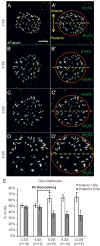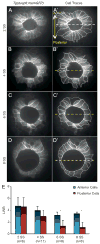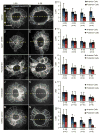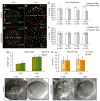Regional cell shape changes control form and function of Kupffer's vesicle in the zebrafish embryo
- PMID: 22841644
- PMCID: PMC3586254
- DOI: 10.1016/j.ydbio.2012.07.019
Regional cell shape changes control form and function of Kupffer's vesicle in the zebrafish embryo
Abstract
Cilia-generated fluid flow in an 'organ of asymmetry' is critical for establishing the left-right body axis in several vertebrate embryos. However, the cell biology underlying how motile cilia produce coordinated flow and asymmetric signals is not well defined. In the zebrafish organ of asymmetry-called Kupffer's vesicle (KV)-ciliated cells are asymmetrically positioned along the anterior-posterior axis such that more cilia are placed in the anterior region. We previously demonstrated that Rho kinase 2b (Rock2b) is required for anteroposterior asymmetry and fluid flow in KV, but it remained unclear how the distribution of ciliated cells becomes asymmetric during KV development. Here, we identify a morphogenetic process we refer to as 'KV remodeling' that transforms initial symmetry in KV architecture into anteroposterior asymmetry. Live imaging of KV cells revealed region-specific cell shape changes that mediate tight packing of ciliated cells into the anterior pole. Mathematical modeling indicated that different interfacial tensions in anterior and posterior KV cells are involved in KV remodeling. Interfering with non-muscle myosin II (referred to as Myosin II) activity, which modulates cellular interfacial tensions and is regulated by Rock proteins, disrupted KV cell shape changes and the anteroposterior distribution of KV cilia. Similar defects were observed in Rock2b depleted embryos. Furthermore, inhibiting Myosin II at specific stages of KV development perturbed asymmetric flow and left-right asymmetry. These results indicate that regional cell shape changes control the development of anteroposterior asymmetry in KV, which is necessary to generate coordinated asymmetric fluid flow and left-right patterning of the embryo.
Copyright © 2012 Elsevier Inc. All rights reserved.
Figures







Similar articles
-
Salient features of the ciliated organ of asymmetry.Bioarchitecture. 2014 Jan-Feb;4(1):6-15. doi: 10.4161/bioa.28014. Epub 2014 Jan 31. Bioarchitecture. 2014. PMID: 24481178 Free PMC article. Review.
-
The Rho kinase Rock2b establishes anteroposterior asymmetry of the ciliated Kupffer's vesicle in zebrafish.Development. 2011 Jan;138(1):45-54. doi: 10.1242/dev.052985. Epub 2010 Nov 23. Development. 2011. PMID: 21098560 Free PMC article.
-
Kupffer's vesicle is a ciliated organ of asymmetry in the zebrafish embryo that initiates left-right development of the brain, heart and gut.Development. 2005 Mar;132(6):1247-60. doi: 10.1242/dev.01663. Epub 2005 Feb 16. Development. 2005. PMID: 15716348
-
Organized chaos in Kupffer's vesicle: how a heterogeneous structure achieves consistent left-right patterning.Bioarchitecture. 2014;4(3):119-25. doi: 10.4161/19490992.2014.956593. Bioarchitecture. 2014. PMID: 25454897 Free PMC article.
-
Cilia in vertebrate left-right patterning.Philos Trans R Soc Lond B Biol Sci. 2016 Dec 19;371(1710):20150410. doi: 10.1098/rstb.2015.0410. Philos Trans R Soc Lond B Biol Sci. 2016. PMID: 27821522 Free PMC article. Review.
Cited by
-
Claudin5a is required for proper inflation of Kupffer's vesicle lumen and organ laterality.PLoS One. 2017 Aug 3;12(8):e0182047. doi: 10.1371/journal.pone.0182047. eCollection 2017. PLoS One. 2017. PMID: 28771527 Free PMC article.
-
Dynamic forces drive cell and organ morphology changes during embryonic development.Proc Natl Acad Sci U S A. 2025 Jul 22;122(29):e2418111122. doi: 10.1073/pnas.2418111122. Epub 2025 Jul 15. Proc Natl Acad Sci U S A. 2025. PMID: 40663599
-
Salient features of the ciliated organ of asymmetry.Bioarchitecture. 2014 Jan-Feb;4(1):6-15. doi: 10.4161/bioa.28014. Epub 2014 Jan 31. Bioarchitecture. 2014. PMID: 24481178 Free PMC article. Review.
-
Left-Right Patterning: Breaking Symmetry to Asymmetric Morphogenesis.Trends Genet. 2017 Sep;33(9):616-628. doi: 10.1016/j.tig.2017.06.004. Epub 2017 Jul 15. Trends Genet. 2017. PMID: 28720483 Free PMC article. Review.
-
Mosaic Labeling and 3-Dimensional Morphological Analysis of Single Cells in the Zebrafish Left-right Organizer.Bio Protoc. 2018 Nov 20;8(22):e3090. doi: 10.21769/BioProtoc.3090. Bio Protoc. 2018. PMID: 30613762 Free PMC article.
References
-
- Amack JD, Wang X, Yost HJ. Two T-box genes play independent and cooperative roles to regulate morphogenesis of ciliated Kupffer’s vesicle in zebrafish. Dev Biol. 2007;310:196–210. - PubMed
-
- Borovina A, Superina S, Voskas D, Ciruna B. Vangl2 directs the posterior tilting and asymmetric localization of motile primary cilia. Nat Cell Biol. 2010;12:407–412. - PubMed
-
- Brakke K. The surface evolver. Exp Math. 1992;1:141–165.
Publication types
MeSH terms
Substances
Grants and funding
LinkOut - more resources
Full Text Sources
Other Literature Sources
Molecular Biology Databases

